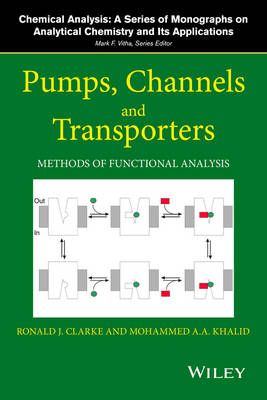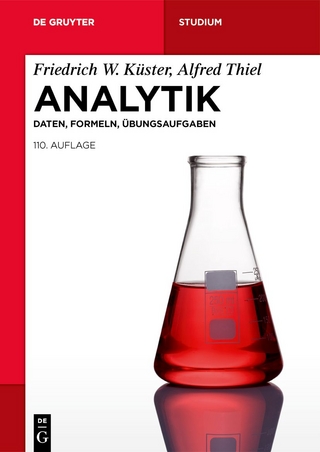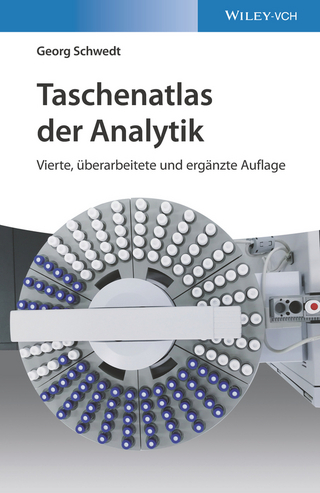
Pumps, Channels and Transporters
John Wiley & Sons Inc (Verlag)
978-1-118-85880-6 (ISBN)
Covers new emerging analytical methods used to study ion transport membrane proteins such as single-molecule spectroscopy
Details a wide range of electrophysiological techniques and spectroscopic methods used to analyze the function of ion channels, ion pumps and transporters
Covers state-of-the art analytical methods to study ion pumps, channels, and transporters, and where analytical chemistry can make further contributions
Ronald J. Clarke, Ph.D. is an Associate Professor in the School of Chemistry, University of Sydney, Australia. In 2010 he was awarded the McAulay-Hope Prize for Original Biophysics by the Australian Society for Biophysics. Mohammed A. A. Khalid, Ph.D. is an Associate Professor in the Department of Chemistry, College of Applied Medical and Sciences at Taif University, Turabah, Saudi Arabia.
Preface xv
List of Contributors xix
1 Introduction 1
Mohammed A. A. Khalid and Ronald J. Clarke
1.1 History 1
1.2 Energetics of Transport 6
1.3 Mechanistic Considerations 7
1.4 Ion Channels 8
1.4.1 Voltage-Gated 8
1.4.2 Ligand-Gated 9
1.4.3 Mechanosensitive 9
1.4.4 Light-Gated 9
1.5 Ion Pumps 10
1.5.1 ATP-Activated 10
1.5.2 Light-Activated 11
1.5.3 Redox-Linked 12
1.6 Transporters 13
1.6.1 Symporters and Antiporters 13
1.6.2 Na+-Linked and H+-Linked 14
1.7 Diseases of Ion Channels, Pumps, and Transporters 15
1.7.1 Channelopathies 15
1.7.2 Pump Dysfunction 17
1.7.3 Transporter Dysfunction 18
1.8 Conclusion 18
References 19
2 Study of Ion Pump Activity Using Black Lipid Membranes 23
Hans-Jürgen Apell and Valerij S. Sokolov
2.1 Introduction 23
2.2 Formation of Black Lipid Membranes 24
2.3 Reconstitution in Black Lipid Membranes 25
2.3.1 Reconstitution of Na+,K+-ATPase in Black Lipid Membranes 25
2.3.2 Recording Transient Currents with Membrane Fragments Adsorbed to a Black Lipid Membrane 26
2.4 The Principles of Capacitive Coupling 28
2.4.1 Dielectric Coefficients 29
2.5 The Gated-Channel Concept 31
2.6 Relaxation Techniques 34
2.6.1 Concentration-Jump Methods 34
2.6.2 Charge-Pulse Method 39
2.7 Admittance Measurements 39
2.8 The Investigation of Cytoplasmic and Extracellular Ion Access Channels in the Na+,K+-ATPase 42
2.9 Conclusions 43
References 45
3 Analyzing Ion Permeation in Channels and Pumps Using Patch-Clamp Recording 51
Andrew J. Moorhouse, Trevor M. Lewis, and Peter H. Barry
3.1 Introduction 51
3.2 Description of the Patch-Clamp Technique 52
3.2.1 Development of Whole-Cell Dialysis with Voltage-Clamp 52
3.3 Patch-Clamp Measurement and Analysis of Single Channel Conductance 54
3.3.1 Conductance and Ohm’s Law 54
3.3.2 Conductance of Channels versus Pumps 56
3.3.3 Fluctuation Analysis 57
3.3.4 Single Channel Recordings 61
3.4 Determining Ion Selectivity and Relative Permeation in Whole-Cell Recordings 67
3.4.1 Dilution Potential Measurements 67
3.4.2 Bi-Ionic Potential Measurements 69
3.4.3 Voltage and Solution Control in Whole-Cell Patch-Clamp Recordings 70
3.4.4 Ion Shift Effects During Whole-Cell Patch-Clamp Experiments 71
3.4.5 Liquid Junction Potential Corrections 72
3.5 Influence of Voltage Corrections in Quantifying Ion Selectivity in Channels 74
3.5.1 Analysis of Counterion Permeation in Glycine Receptor Channels 74
3.5.2 Analysis of Anion-Cation Permeability in
Cation-Selective Mutant Glycine Receptor Channels 75
3.6 Ion Permeation Pathways through Channels and Pumps 76
3.6.1 The Ion Permeation Pathway in Pentameric Ligand-Gated Ion Channels 76
3.6.1.1 Extracellular and Intracellular Components of the Permeation Pathway 78
3.6.1.2 The TM2 Pore is the Primary Ion Selectivity Filter 79
3.6.2 Ion Permeation Pathways in Pumps Identified Using Patch-Clamp 80
3.6.2.1 Palytoxin Uncouples the Occluded Gates of the Na+,K+-ATPase 81
3.7 Conclusions 82
References 83
4 Probing Conformational Transitions of Membrane Proteins with Voltage Clamp Fluorometry (VCF) 89
Thomas Friedrich
4.1 Introduction 89
4.2 Description of The Vcf Technique 90
4.2.1 Generation of Single-Cysteine Reporter Constructs, Expression in Xenopus laevis Oocytes, Site-Directed Fluorescence Labeling 90
4.2.2 VCF Instrumentation 91
4.2.3 Technical Precautions and Controls 93
4.3 Perspectives from Early Measurements on Voltage-Gated K+ Channels 95
4.3.1 Early Results Obtained with VCF on Voltage-Gated K+ Channels 95
4.3.2 Probing the Environmental Changes: Fluorescence Spectra, Anisotropy, and the Effects of Quenchers 98
4.4 Vcf Applied to P-Type Atpases 100
4.4.1 Structural and Functional Aspects of Na+, K+- and H+,K+-ATPase 100
4.4.2 The N790C Sensor Construct of Sheep Na+,K+-ATPase α1-Subunit 102
4.4.2.1 Probing Voltage-Dependent Conformational Changes of Na+,K+-ATPase 103
4.4.2.2 The Influence of Intracellular Na+ Concentrations 107
4.4.3 The Rat Gastric H+,K+-ATPase S806C Sensor Construct 108
4.4.3.1 Voltage-Dependent Conformational Shifts of the H+,K+-ATPase Sensor Construct S806C
During the H+ Transport Branch 109
4.4.3.2 An Intra- or Extracellular Access Channel of the Proton Pump? 110
4.4.3.3 Effects of Extracellular Ligands: K+ and Na+ 111
4.4.4 Probing Intramolecular Distances by Double Labeling and FRET 113
4.5 Conclusions and Perspectives 116
References 117
5 Patch Clamp Analysis of Transporters via Pre-Steady-State Kinetic Methods 121
Christof Grewer
5.1 Introduction 121
5.2 Patch Clamp Analysis of Secondary-Active Transporter Function 122
5.2.1 Patch Clamp Methods 122
5.2.2 Whole-Cell Recording 124
5.2.3 Recording from Excised Patches 124
5.3 Perturbation Methods 125
5.3.1 Concentration Jumps 126
5.3.2 Voltage Jumps 129
5.4 Evaluation and Interpretation of Pre-Steady-State Kinetic Data 130
5.4.1 Integrating Rate Equations that Describe Mechanistic Transport Models 131
5.4.2 Assigning Kinetic Components to Elementary processes in the Transport Cycle 131
5.5 Mechanistic Insight into Transporter Function 133
5.5.1 Sequential Binding Mechanism 133
5.5.2 Electrostatics 134
5.5.3 Structure-Function Analysis 134
5.6 Case Studies 136
5.6.1 Glutamate Transporter Mechanism 136
5.6.2 Electrogenic Charge Movements Associated with the Electroneutral Amino Acid Exchanger ASCT2 137
5.7 Conclusions 139
References 139
6 Recording of Pump and Transporter Activity Using Solid-Supported Membranes (SSM-Based Electrophysiology) 147
Francesco Tadini-Buoninsegni and Klaus Fendler
6.1 Introduction 147
6.2 The Instrument 148
6.2.1 Rapid Solution Exchange Cuvette 149
6.2.2 Setup and Flow Protocols 150
6.2.3 Protein Preparations 151
6.2.4 Commercial Instruments 152
6.3 Measurement Procedures, Data Analysis, and Interpretation 152
6.3.1 Current Measurement, Signal Analysis, and Reconstruction of Pump Currents 152
6.3.2 Voltage Measurement 156
6.3.3 Solution Exchange Artifacts 157
6.4 P-Type Atp ases Investigated by Ssm-Based Electrophysiology 159
6.4.1 Sarcoplasmic Reticulum Ca2+-ATPase 159
6.4.2 Human Cu+-ATPases ATP7A and ATP7B 163
6.5 Secondary Active Transporters 165
6.5.1 Antiport: Assessing the Forward and Reverse Modes of the NhaA Na+/H+ Exchanger of E. coli 166
6.5.2 Cotransport: A Sugar-Induced Electrogenic Partial Reaction in the Lactose Permease LacY of E. coli 168
6.5.3 The Glutamate Transporter EAAC1: A Robust Electrophysiological Assay with High Information Content 170
6.6 Conclusions 172
References 173
7 Stopped-Flow Fluorimetry Using Voltage-Sensitive Fluorescent Membrane Probes 179
Ronald J. Clarke and Mohammed A. A. Khalid
7.1 Introduction 179
7.2 Basics of the Stopped-Flow Technique 181
7.2.1 Flow Cell Design 181
7.2.2 Rapid Data Acquisition 181
7.2.3 Dead Time 183
7.3 Covalent Versus Noncovalent Fluorescence Labeling 184
7.3.1 Intrinsic Fluorescence 185
7.3.2 Covalently Bound Extrinsic Fluorescent Probes 186
7.3.3 Noncovalently Bound Extrinsic Fluorescent Probes 187
7.4 Classes of Voltage-Sensitive Dyes 188
7.4.1 Slow Dyes 188
7.4.2 Fast Dyes 190
7.5 Measurement of the Kinetics of the Na+,K+-Atpase 193
7.5.1 Dye Concentration 194
7.5.2 Excitation Wavelength and Light Source 197
7.5.3 Monochromators and Filters 198
7.5.4 Photomultiplier and Voltage Supply 199
7.5.5 Reactions Detected by RH421 200
7.5.6 Origin of the RH421 Response 202
7.6 Conclusions 204
References 204
8 Nuclear Magnetic Resonance Spectroscopy 211
Philip W. Kuchel
8.1 Introduction 211
8.1.1 Definition of NMR 212
8.1.2 Why So Useful? 212
8.1.3 Magnetic Polarization 212
8.1.4 Larmor Equation 213
8.1.5 Chemical Shift 213
8.1.6 Free Induction Decay 214
8.1.7 Pulse Excitation 215
8.1.8 Relaxation Times 217
8.1.9 Splitting of Resonance Lines 217
8.1.10 Measuring Membrane Transport 217
8.2 Covalently-Induced Chemical Shift Differences 218
8.2.1 Arginine Transport 218
8.2.2 Other Examples 220
8.3 Shift-Reagent-Induced Chemical Shift Differences 220
8.3.1 DyPPP 220
8.3.2 TmDTPA and TmDOTP 220
8.3.3 Fast Cation Exchange 220
8.4 pH-Induced Chemical Shift Differences 223
8.4.1 Orthophosphate 223
8.4.2 Methylphosphonate 224
8.4.3 Triethylphosphate: 31P Shift Reference 224
8.5 Hydrogen-Bond-Induced Chemical Shift Differences 225
8.5.1 Phosphonates: DMMP 225
8.5.2 HPA 225
8.5.3 Fluorides 227
8.6 Ionic-Environment-Induced Chemical Shift Differences 229
8.6.1 Cs+ Transport 229
8.7 Relaxation Time Differences 229
8.7.1 Mn2+ Doping 229
8.8 Diffusion Coefficient Differences 231
8.8.1 Stejskal-Tanner Plot 231
8.8.2 Andrasko’s Method 231
8.9 Some Subtle Spectral Effects 233
8.9.1 Scalar (J) Coupling Differences 233
8.9.2 Endogenous Magnetic Field Gradients 233
8.9.2.1 Magnetic Induction and Magnetic Field Strength 234
8.9.2.2 Magnetic Field Gradients Across Cell Membranes and CO Treatment of RBCs 234
8.9.2.3 Exploiting Magnetic Field Gradients in Membrane Transport Studies 235
8.9.3 Residual Quadrupolar (νQ) Coupling 235
8.10 A Case Study: The Stoichiometric Relationship Between the Number of Na+ Ions Transported per Molecule of Glucose Consumed in Human Rbcs 236
8.11 Conclusions 239
References 239
9 Time-Resolved and Surface-Enhanced Infrared Spectroscopy 245
Joachim Heberle
9.1 Introduction 245
9.2 Basics of Ir Spectroscopy 246
9.2.1 Vibrational Spectroscopy 246
9.2.2 FTIR Spectroscopy 247
9.2.3 IR Spectra of Biological Compounds 248
9.2.4 Difference Spectroscopy 250
9.3 Reflection Techniques 250
9.3.1 Attenuated Total Reflection 250
9.3.2 Surface-Enhanced IR Absorption 251
9.4 Application to Electron-Transferring Proteins 252
9.4.1 Cytochrome c 252
9.4.2 Cytochrome c Oxidase 253
9.5 Time-Resolved ir Spectroscopy 254
9.5.1 The Rapid-Scan Technique 254
9.5.2 The Step-Scan Technique 255
9.5.3 Tunable QCLs 255
9.6 Applications to Retinal Proteins 256
9.6.1 Bacteriorhodopsin 256
9.6.2 Channelrhodopsin 260
9.7 Conclusions 263
References 264
10 Analysis of Membrane-Protein Complexes by Single-Molecule Methods 269
Katia Cosentino, Stephanie Bleicken, and Ana J. García-Sáez
10.1 Introduction 269
10.2 Fluorophores for Single Particle Labeling 270
10.3 Principles of Fluorescence Correlation Spectroscopy 271
10.3.1 Analysis of Molecular Complexes by Two-Color FCS 275
10.3.2 FCS Variants to Study Lipid Membranes 275
10.3.3 FCS Applications to Membranes 278
10.4 Principle and Analysis of Single-Molecule Imaging 279
10.4.1 TIRF Microscopy 280
10.4.2 Single-Molecule Detection 282
10.4.3 Single Particle Tracking and Trajectory Analysis 284
10.5 Complex Dynamics and Stoichiometry by Single-Molecule Microscopy 285
10.5.1 Application to Single-Molecule Stoichiometry Analysis 285
10.5.2 Application to Kinetics Processes in Cell Membranes 290
10.6 Fcs Versus Spt 291
References 291
11 Probing Channel, Pump, and Transporter Function Using Single-Molecule Fluorescence 299
Eve E. Weatherill, John S. H. Danial, and Mark I. Wallace
11.1 Introduction 299
11.1.1 Basic Principles 300
11.2 Practical Considerations 300
11.2.1 Observables 301
11.2.2 Apparatus 301
11.2.3 Labels 302
11.2.4 Bilayers 303
11.3 smf Imaging 303
11.3.1 Fluorescence Colocalization 304
11.3.2 Conformational Changes 306
11.3.3 Superresolution Microscopy 307
11.4 Single Molecule Förster Resonance Energy Transfer 308
11.4.1 Interactions/Stoichiometry 308
11.4.2 Conformational Changes 309
11.5 Single-Molecule Counting by Photobleaching 312
11.6 Optical Channel Recording 314
11.7 Simultaneous Techniques 315
11.8 Summary 318
References 318
12 Electron Paramagnetic Resonance: Site-Directed Spin Labeling 327
Louise J. Brown and Joanna E. Hare
12.1 Introduction 327
12.1.1 Development of EPR as a Tool for Structural Biology 329
12.1.2 SDSL-EPR: A Complementary Approach to Determine Structure-Function Relationships 330
12.2 Basics of the Epr Method 331
12.2.1 Physical Basis of the EPR Signal 331
12.2.2 Spin Labeling 333
12.2.3 EPR Instrumentation 336
12.3 Structural and Dynamic Information from Sdsl-Epr 336
12.3.1 Mobility Measurements 336
12.3.2 Solvent Accessibility 341
12.4 Distance Measurements 345
12.4.1 Interspin Distance Measurements 345
12.4.2 Continuous Wave 347
12.4.3 Pulsed Methods: DEER 349
12.5 Challenges 353
12.5.1 New Labels 353
12.5.2 Spin-Label Flexibility 355
12.5.3 Production and Reconstitution Challenges: Nanodiscs 355
12.6 Conclusions 356
References 357
13 Radioactivity-Based Analysis of Ion Transport 367
Ingolf Bernhardt and J. Clive Ellory
13.1 Introduction 367
13.2 Membrane Permeability for Electroneutral Substances and Ions 368
13.3 Kinetic Considerations 370
13.4 Techniques for Ion Flux Measurements 371
13.4.1 Conventional Methods 371
13.4.2 Alternative Method 373
13.5 Kinetic Analysis of Ion Transporter Properties 375
13.6 Selected Cation Transporter Studies on Red Blood Cells 376
13.6.1 K+,Cl− Cotransport (KCC) 378
13.6.2 Residual Transport 378
13.7 Combination of Radioactive Isotope Studies with Methods using Fluorescent Dyes 379
13.8 Conclusions 382
References 383
14 Cation Uptake Studies with Atomic Absorption Spectrophotometry (Aas) 387
Thomas Friedrich
14.1 Introduction 387
14.2 Overview of the Technique of Aas 389
14.2.1 Historical Account of AAS with Flame Atomization 390
14.2.2 Element-Specific Radiation Sources 391
14.2.3 Electrothermal Atomization in Heated Graphite Tubes 392
14.2.4 Correction for Background Absorption 394
14.3 The Expression System of Xenopus laevis Oocytes for Cation Flux Studies: Practical Considerations 395
14.4 Experimental Outline of the Aas Flux Quantification Technique 395
14.5 Representative Results Obtained with the Aas Flux Quantification Technique 397
14.5.1 Reaction Cycle of P-Type ATPases 398
14.5.2 Rb+ Uptake Kinetics: Inhibitor Sensitivity 398
14.5.3 Dependence of Rb+ Transport of Gastric H+,K+-ATPase on Extra- and Intracellular pH 400
14.5.4 Determination of Na+,K+-ATPase Transport Stoichiometry and Voltage Dependence of H+,K+-ATPase Rb+ Transport 403
14.5.5 Effects of C-Terminal Deletions of the H+,K+-ATPase α-Subunit 404
14.5.6 Li+ and Cs+ Uptake Studies 405
14.6 Concluding Remarks 407
References 408
15 Long Timescale Molecular Simulations for Understanding Ion Channel Function 411
Ben Corry
15.1 Introduction 411
15.2 Fundamentals of Md Simulation 412
15.2.1 The Main Idea 412
15.2.2 Force Fields 414
15.2.3 O ther Simulation Considerations 416
15.2.4 Why Do MD Simulations Take So Much Computational Power? 416
15.2.4.1 Force Calculations 417
15.2.4.2 Time Step 417
15.3 Simulation Duration and Simulation Size 418
15.4 Historical Development of Long Md Simulations 421
15.5 Limitations and Challenges Facing Md Simulations 423
15.5.1 Force Field and Algorithm Accuracy 423
15.5.2 Sampling Problems 424
15.6 Example Simulations of Ion Channels 425
15.6.1 Simulations of Ion Permeation 425
15.6.2 Simulations of Ion Selectivity 428
15.6.3 Simulations of Channel Gating 432
15.7 Conclusions 433
References 436
Index 443
Chemical Analysis: A Series of Monographs on Analytical
Chemistry and its Applications 461
| Reihe/Serie | Chemical Analysis: A Series of Monographs on Analytical Chemistry and Its Applications |
|---|---|
| Verlagsort | New York |
| Sprache | englisch |
| Maße | 160 x 241 mm |
| Gewicht | 794 g |
| Themenwelt | Naturwissenschaften ► Biologie |
| Naturwissenschaften ► Chemie ► Analytische Chemie | |
| Naturwissenschaften ► Physik / Astronomie | |
| ISBN-10 | 1-118-85880-8 / 1118858808 |
| ISBN-13 | 978-1-118-85880-6 / 9781118858806 |
| Zustand | Neuware |
| Informationen gemäß Produktsicherheitsverordnung (GPSR) | |
| Haben Sie eine Frage zum Produkt? |
aus dem Bereich


